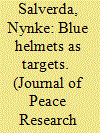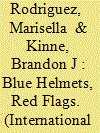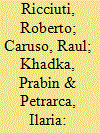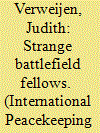|
|
|
Sort Order |
|
|
|
Items / Page
|
|
|
|
|
|
|
| Srl | Item |
| 1 |
ID:
124983


|
|
|
|
|
| Publication |
2013.
|
| Summary/Abstract |
A majority of UN peacekeeping operations deployed to civil wars face violent attacks by rebel groups. To date, the academic study of this type of violence has been very limited. This article is a first attempt to fill this gap. In particular, I aim to examine why rebel groups fight against peacekeepers in some cases, while not in others. I argue that since peacekeepers are mostly impartial but not neutral, they become an actor in a conflict and tend to protect the weaker side from total defeat. This implies that on the one hand, relatively weaker rebels will seek protection from the government by peacekeepers. On the other hand, relatively stronger rebels will challenge the peacekeepers in order to restrict their behavior and/or make them withdraw. If stronger rebels are successful in targeting the peacekeepers and the peacekeepers withdraw or alter their behavior, a victory for these rebel groups should become easier. Using novel data on violence against UN peacekeepers, I find that indeed, stronger rebel groups are more likely to fight against peacekeepers.
|
|
|
|
|
|
|
|
|
|
|
|
|
|
|
|
| 2 |
ID:
168552


|
|
|
|
|
| Summary/Abstract |
United Nations peacekeeping soldiers commit atrocities while deployed despite their mandate to protect civilians from harm. Yet, there is tremendous variation across missions in reported human rights abuses. Why are some missions more susceptible to misconduct than others? To answer this puzzle, we identify three broad sources of influence on peacekeeper behavior: institutions, society, and military culture. Using newly collected data, we find that host-country and contributing-country institutions, particularly press freedoms and rule of law, dramatically decrease violations. Compliance with international humanitarian law also decreases violations, though to a lesser degree than institutions. Societal influences, such as gender norms and income inequality, have virtually no impact on abuses. We illustrate the utility of these findings by generating out-of-sample predictions for hypothetical peacekeeping missions in countries with recent political turmoil.
|
|
|
|
|
|
|
|
|
|
|
|
|
|
|
|
| 3 |
ID:
151712


|
|
|
|
|
| Summary/Abstract |
This paper investigates the effect of the deployment of United Nations Blue Helmets on economic activity in South Sudan with a special focus on agricultural production. Since UN troops are predicted to improve security, in particular, we expect a positive relationship between deployment of UN blue Helmets and cereal production. We test our hypothesis using an original data-set including all the 78 South Sudanese counties over the period 2009–2011. We control for the non-random assignment of UN troops through an Instrumental Variables approach. Our empirical results show that a 10% increase in the size of the troop allows the production of additional 600 tonnes.
|
|
|
|
|
|
|
|
|
|
|
|
|
|
|
|
| 4 |
ID:
153526


|
|
|
|
|
| Summary/Abstract |
The literature on peacekeeping has paid scant attention to the interaction between peacekeeping troops and host country military. Addressing this gap in scholarly knowledge, this paper conceptualizes such interaction as ‘diagonal interoperability’. The latter is situated in-between ‘horizontal interoperability’ on the one hand, relating to interaction between different components of a peacekeeping mission, and ‘vertical interoperability’ on the other, referring to the relations between international peacekeepers and ‘peace-kept’ populations. The paper focuses on the Democratic Republic of the Congo, where UN forces and the Congolese army are engaged in joint military operations and army reform is part of the peacekeeping mission’s mandate. Studying both mutual representations and joint practices, the paper explores the organizational, political, discursive, and security-related factors that shape diagonal interoperability. It concludes that diagonal interoperability between the two forces is weak, as reflected in mutual distrust and ‘not-so joint’ joint operations. Perhaps surprisingly, it finds that shared military identities do not seem to facilitate collaboration. Rather, mutual perceptions of the ‘military Other’ are infused with discourses of cultural and political difference, therefore accentuating the power asymmetries that undermine diagonal interoperability.
|
|
|
|
|
|
|
|
|
|
|
|
|
|
|
|
|
|
|
|
|